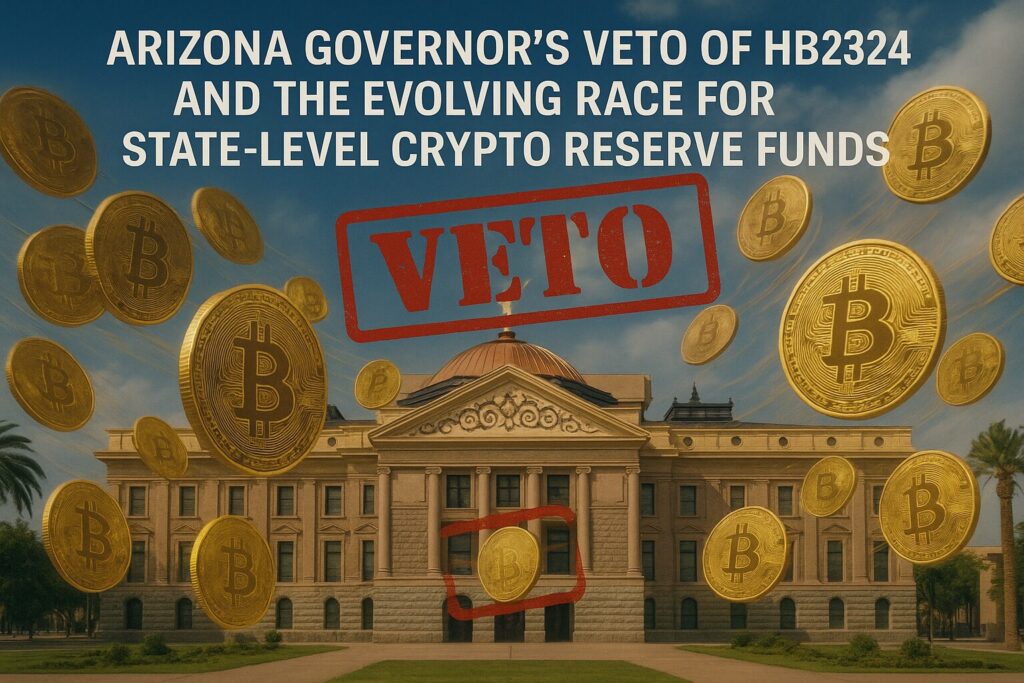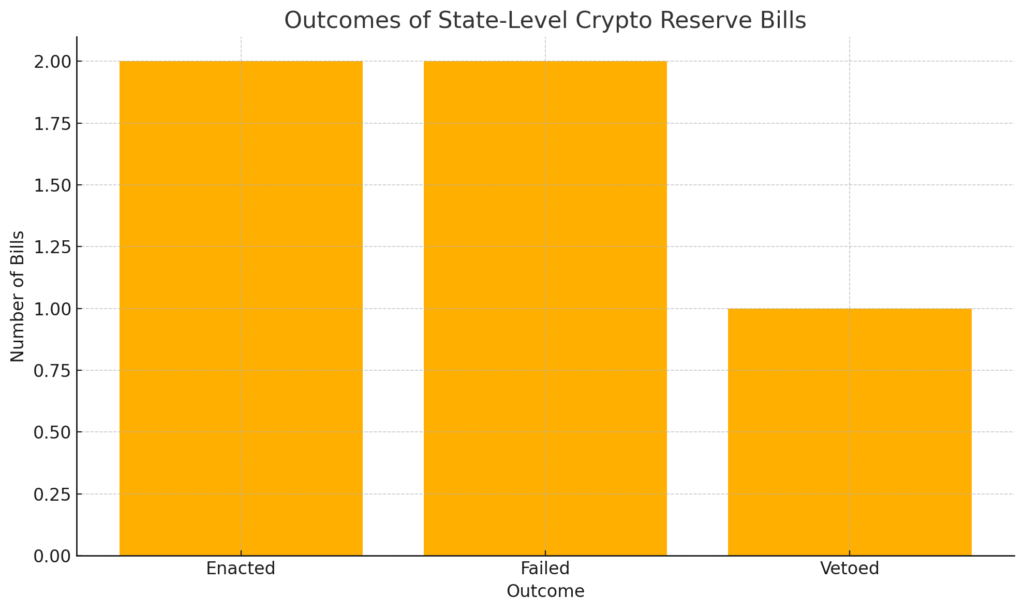
Main Points:
- Arizona Governor Katie Hobbs vetoed HB2324 on July 1, 2025, halting the creation of a state-managed cryptocurrency reserve fund.
- The bill would have redirected seized crypto assets into a “Bitcoin & Digital Assets Reserve Fund,” with the first $300,000 from each forfeiture earmarked for the Attorney General’s office and the remainder split between the AG, general fund, and reserve.
- Hobbs cited concerns that centralizing seized assets at the state level would undermine incentives for local law enforcement to pursue and seize crypto-related criminal assets.
- Texas and New Hampshire have successfully enacted strategic Bitcoin reserve laws in June 2025, positioning public crypto holdings as an inflation hedge.
- Similar bills in Oklahoma and Pennsylvania failed earlier this year and in late 2024, illustrating the mixed legislative environment.
- Broader national context: state-level crypto reserve initiatives reflect growing institutional interest in Bitcoin’s role as “digital gold,” though volatility concerns persist.
Background: The Veto of HB2324
On July 1, 2025, Arizona Governor Katie Hobbs (D) exercised her veto power over HB2324, a bill that would have authorized the State Treasurer to establish a “Bitcoin & Digital Assets Reserve Fund” using cryptocurrencies seized during criminal prosecutions. The measure had passed the Arizona House by a 34–22 margin, marking the state’s second attempt in 2025 to legislate public crypto holdings after Governor Hobbs previously vetoed SB1373, which sought to allow state and pension funds to hold Bitcoin directly.
Hobbs explained her decision by emphasizing the importance of preserving local incentives for law enforcement agencies. Under HB2324, local agencies would forfeit direct access to seized crypto assets, with the bulk transferred to a centralized state fund. By reallocating these proceeds, the bill risked diminishing police cooperation in crypto seizures—cooperation that currently yields local budgetary benefits and motivates active pursuit of crypto-linked crime.
Mechanics of HB2324
- Forfeited Assets Flow:
- First $300,000 per seizure → Arizona Attorney General’s Anti-Racketeering Revolving Fund
- Remaining funds: 50% → Attorney General’s office; 25% → Arizona General Fund; 25% → Crypto Reserve Fund
- Reserve Operations:
- Managed by the State Treasurer
- Permitted actions: hold digital assets, liquidate to fiat, or invest in regulated ETFs
- No explicit annual audit requirement, though stringent custody standards were proposed
- Rationale:
- Create an inflation hedge for state finances
- Leverage seized assets rather than taxpayer dollars to fund law enforcement and public services
- Signal Arizona’s role in innovative fiscal policy
Local Law Enforcement Incentives
Governor Hobbs underscored that Arizona’s local police departments rely on a share of forfeiture proceeds to fund equipment, personnel, and training. By diverting these funds to a state-controlled pool, HB2324 could have inadvertently reduced active enforcement against crypto-fueled crime, undercutting public safety objectives.
National Context: A Patchwork of Crypto Reserves
Arizona’s veto arrives amid a flurry of state-level initiatives:
- Texas (SB21) – Signed into law June 21, 2025, by Governor Greg Abbott, the Texas Strategic Bitcoin Reserve allows surplus funds, forks, airdrops, and even public donations to feed a state-managed Bitcoin pool, held in deep cold storage and subject to biennial public reporting.
- New Hampshire (HB2864) – Enacted June 30, 2025, establishing a reserve fund for unclaimed crypto assets exclusively sourced from private forfeitures and donations.
- Oklahoma (HB1203) – Passed the House February 25, 2025, but failed in the Senate Tax Committee in April (6–5 vote), reflecting bipartisan skepticism.
- Pennsylvania (Bitcoin Strategic Reserve Act) – Introduced November 2024, permitting up to 10% of select public funds in Bitcoin; died in committee before a vote.
These mixed outcomes highlight diverging state approaches: Texas and New Hampshire embrace public crypto holdings, while Oklahoma, Pennsylvania, and twice Arizona have balked at either fiscal risk or law enforcement trade-offs.
Benefits and Risks of State Crypto Reserves
Benefits:
- Inflation Hedge: Bitcoin’s capped supply and historical performance can safeguard state assets against currency debasement.
- Asset Diversification: Adds non-correlated digital assets to traditional portfolios of cash, bonds, and equities.
- Seizure Utilization: Converts illiquid forfeitures into productive reserves without direct taxpayer expense.
Risks:
- Volatility: Bitcoin’s swings (e.g., ±40% annually) could imperil budget forecasts.
- Custody & Security: Requires rigorous protocols—cold storage, multisig, audited custodians.
- Political Backlash: Public scrutiny over losses could derail future fiscal plans.
- Law Enforcement Incentives: Centralization may reduce local agency motivation for crypto crime enforcement.
Recent Trends and Market Data
In mid-2025, Bitcoin traded between $55,000 and $65,000, reflecting a period of moderate consolidation after cyclical highs in early 2024. Public filings from Texas show its reserve acquired approximately 1,000 BTC (valued at $60 million at $60,000/BTC) within weeks of enactment, leveraging market dips for tactical purchases. Meanwhile, New Hampshire’s initial reserve balance stands at roughly $2 million, derived entirely from private forfeitures.
Illustrative Outcomes of State Bills
Below is an overview of five notable crypto reserve bills introduced in the U.S. this cycle, showing varied outcomes by July 2025. This data reflects enacted, vetoed, or failed state measures.
Main Points:
- Arizona Governor Katie Hobbs vetoed HB2324 on July 1, 2025, halting the creation of a state-managed cryptocurrency reserve fund.
- The bill would have redirected seized crypto assets into a “Bitcoin & Digital Assets Reserve Fund,” with the first $300,000 from each forfeiture earmarked for the Attorney General’s office and the remainder split between the AG, general fund, and reserve.
- Hobbs cited concerns that centralizing seized assets at the state level would undermine incentives for local law enforcement to pursue and seize crypto-related criminal assets.
- Texas and New Hampshire have successfully enacted strategic Bitcoin reserve laws in June 2025, positioning public crypto holdings as an inflation hedge.
- Similar bills in Oklahoma and Pennsylvania failed earlier this year and in late 2024, illustrating the mixed legislative environment.
- Broader national context: state-level crypto reserve initiatives reflect growing institutional interest in Bitcoin’s role as “digital gold,” though volatility concerns persist.
Background: The Veto of HB2324
On July 1, 2025, Arizona Governor Katie Hobbs (D) exercised her veto power over HB2324, a bill that would have authorized the State Treasurer to establish a “Bitcoin & Digital Assets Reserve Fund” using cryptocurrencies seized during criminal prosecutions. The measure had passed the Arizona House by a 34–22 margin, marking the state’s second attempt in 2025 to legislate public crypto holdings after Governor Hobbs previously vetoed SB1373, which sought to allow state and pension funds to hold Bitcoin directly.
Hobbs explained her decision by emphasizing the importance of preserving local incentives for law enforcement agencies. Under HB2324, local agencies would forfeit direct access to seized crypto assets, with the bulk transferred to a centralized state fund. By reallocating these proceeds, the bill risked diminishing police cooperation in crypto seizures—cooperation that currently yields local budgetary benefits and motivates active pursuit of crypto-linked crime.
Mechanics of HB2324
- Forfeited Assets Flow:
- First $300,000 per seizure → Arizona Attorney General’s Anti-Racketeering Revolving Fund
- Remaining funds: 50% → Attorney General’s office; 25% → Arizona General Fund; 25% → Crypto Reserve Fund
- Reserve Operations:
- Managed by the State Treasurer
- Permitted actions: hold digital assets, liquidate to fiat, or invest in regulated ETFs
- No explicit annual audit requirement, though stringent custody standards were proposed
- Rationale:
- Create an inflation hedge for state finances
- Leverage seized assets rather than taxpayer dollars to fund law enforcement and public services
- Signal Arizona’s role in innovative fiscal policy
Local Law Enforcement Incentives
Governor Hobbs underscored that Arizona’s local police departments rely on a share of forfeiture proceeds to fund equipment, personnel, and training. By diverting these funds to a state-controlled pool, HB2324 could have inadvertently reduced active enforcement against crypto-fueled crime, undercutting public safety objectives.
National Context: A Patchwork of Crypto Reserves
Arizona’s veto arrives amid a flurry of state-level initiatives:
- Texas (SB21) – Signed into law June 21, 2025, by Governor Greg Abbott, the Texas Strategic Bitcoin Reserve allows surplus funds, forks, airdrops, and even public donations to feed a state-managed Bitcoin pool, held in deep cold storage and subject to biennial public reporting.
- New Hampshire (HB2864) – Enacted June 30, 2025, establishing a reserve fund for unclaimed crypto assets exclusively sourced from private forfeitures and donations.
- Oklahoma (HB1203) – Passed the House February 25, 2025, but failed in the Senate Tax Committee in April (6–5 vote), reflecting bipartisan skepticism.
- Pennsylvania (Bitcoin Strategic Reserve Act) – Introduced November 2024, permitting up to 10% of select public funds in Bitcoin; died in committee before a vote.
These mixed outcomes highlight diverging state approaches: Texas and New Hampshire embrace public crypto holdings, while Oklahoma, Pennsylvania, and twice Arizona have balked at either fiscal risk or law enforcement trade-offs.
Benefits and Risks of State Crypto Reserves
Benefits:
- Inflation Hedge: Bitcoin’s capped supply and historical performance can safeguard state assets against currency debasement.
- Asset Diversification: Adds non-correlated digital assets to traditional portfolios of cash, bonds, and equities.
- Seizure Utilization: Converts illiquid forfeitures into productive reserves without direct taxpayer expense.
Risks:
- Volatility: Bitcoin’s swings (e.g., ±40% annually) could imperil budget forecasts.
- Custody & Security: Requires rigorous protocols—cold storage, multisig, audited custodians.
- Political Backlash: Public scrutiny over losses could derail future fiscal plans.
- Law Enforcement Incentives: Centralization may reduce local agency motivation for crypto crime enforcement.
Recent Trends and Market Data
In mid-2025, Bitcoin traded between $55,000 and $65,000, reflecting a period of moderate consolidation after cyclical highs in early 2024. Public filings from Texas show its reserve acquired approximately 1,000 BTC (valued at $60 million at $60,000/BTC) within weeks of enactment, leveraging market dips for tactical purchases. Meanwhile, New Hampshire’s initial reserve balance stands at roughly $2 million, derived entirely from private forfeitures.
Illustrative Outcomes of State Bills
Below is an overview of five notable crypto reserve bills introduced in the U.S. this cycle, showing varied outcomes by July 2025. This data reflects enacted, vetoed, or failed state measures.

(Interactive table and bar chart displayed above.)
Implications for Investors and Practitioners
For crypto investors and blockchain practitioners, these developments signal growing institutional demand for digital assets. Successful state reserves could spur private entities—universities, endowments, and corporations—to explore Bitcoin allocations, broadening the asset’s legitimacy. However, volatility and regulatory uncertainty remain hurdles. Firms building on-chain compliance tools, custody solutions, and forensic services stand to benefit from expanded government crypto engagement, as states seek secure, transparent frameworks.
Conclusion
Arizona’s veto of HB2324 underscores the delicate balance between innovative fiscal policy and practical law enforcement incentives. While Texas and New Hampshire have charted a course toward public crypto reserves, other states hesitate over volatility and custody complexities. For investors seeking new opportunities, these state-level experiments offer a signal: blockchain and digital assets are steadily permeating institutional finance. Yet, realizing their full potential demands robust risk management, clear auditing standards, and alignment with stakeholder incentives. As the U.S. landscape evolves, the interplay of legislation, market dynamics, and technological safeguards will shape the next frontier of cryptocurrency adoption.

